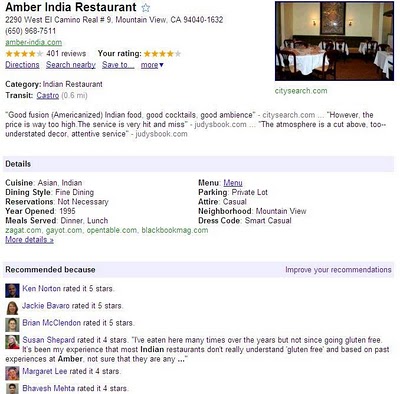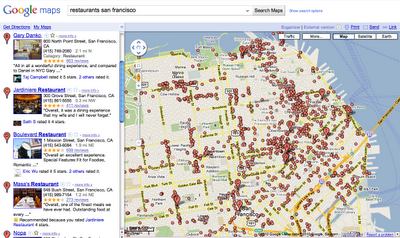How Long Has Marissa M Been Testing Hotspot?
 Gary Danko, is not the sort of restaurant that I would typically eat at, not that I wouldn’t like to try it one day. Dinners run towards $200/ head. While, it is unlikely I ever will eat there, the many, many reviews provide for some interesting reading.
Gary Danko, is not the sort of restaurant that I would typically eat at, not that I wouldn’t like to try it one day. Dinners run towards $200/ head. While, it is unlikely I ever will eat there, the many, many reviews provide for some interesting reading.
I presume that the word starving is not meant literally in this context.
But it also appears to be a favorite haunt for Googlers, particularly those on the Maps team. This includes both long time veterans and some recent arrivals. In the body of reviews there are some interesting narratives and insights (both real and imagined).
![]() Carter doesn’t appear all that cracked up about the place giving it but a one star Hotpot rating. Lior Ron, a senior product manager on the Maps team on the other hand ate there on September 18th and gave it 5 stars. Marissa M also seemed to really enjoy it here, giving it a 5 star rating.
Carter doesn’t appear all that cracked up about the place giving it but a one star Hotpot rating. Lior Ron, a senior product manager on the Maps team on the other hand ate there on September 18th and gave it 5 stars. Marissa M also seemed to really enjoy it here, giving it a 5 star rating.
 Her Hotpot rating, a feature not available to mere mortals until this month, was created on January 21st, 2010. She shows two periods of intense Hotpot ratings prior to introduction ( August 13th and January 21st )Hmm… perhaps she was thinking of working in Local long before her job description rewrite in October?
Her Hotpot rating, a feature not available to mere mortals until this month, was created on January 21st, 2010. She shows two periods of intense Hotpot ratings prior to introduction ( August 13th and January 21st )Hmm… perhaps she was thinking of working in Local long before her job description rewrite in October?
Theirs weren’t the only “early” ratings to show. Gary Danko also seems to not just be a hangout for Googlers but to be a testing grounds for Hotpot with 250 of the 290 Google reviews appearing to be ratings, many of which occurred long before Hotpot was released.
The reviews combined with the many ratings also provide an inkling into the relative algorithmic importance of reviews vs ratings. Take a look at the general ordering of the different review types on this page and note that long form reviews are shown first in date order (with the exception of the most recent), followed by Hotpot ratings that include brief reviews again in date order, followed by ratings with no comments. It would appear that if you want your review to really count, take some time and add some detail!
So what have we learned with this guided tour of Gay Danko’s reviews? Carter and Marissa M seem to have dramatically different tastes in restaurants. Googlers are obviously spending way too much on eating out. They typically are NOT eating at restaurants that serve hotpot.
The key take away for me is….
Upon entering Gary Danko’s never shout loudly with an Android glued to your ear: I have a call here for a Google Employee From Sergey! You might get hurt.
How ratings and reviews work on Google Places
Ratings, reviews and recommendations play an important role in helping people find great places they love. Now that Google Hotpot is available, we want to take the opportunity to share some details on how the Google ratings and reviews system works and remind you of some of the features we’ve launched over the last couple of months.
Whether you’re trying to find a restaurant for some out-of-town relatives or looking for a reputable watch repairman in your neighborhood, your decision-making process is likely to include reading reviews online so you can pick a place that’s right for you. Google helps you find these helpful perspectives about local businesses and services regardless of where on Google you started your search.
Where reviews appear
On the Place page of a business, the “Reviews from around the web” section shows results from the most relevant review sites from across the Web.
In the “Reviews from Google users” section you can read additional reviews that people have posted directly on Google Places. And of course, you can rate the place and write your own review to share your opinions with your friends and other users.
And now with Hotpot, some Place pages may also include a new section called “Recommended because,” which shows you what the friends you’ve added in Hotpot think about various places through their star ratings and reviews.

Also with the addition of Hotpot, if you’re signed in, we’ll use the ratings and reviews from you and your friends to show personalized recommendations in Google search results. These opinions from the people you trust will also be available when searching on Google Maps and Google Maps for Android.

How we handle reviews
We want people to see ratings, reviews and recommendations that are relevant, helpful, and trustworthy. Unfortunately not all reviews and ratings found across the web are entirely honest or legitimate. So to protect both business owners and customers from fake or malicious reviews, we have systems in place that may remove individual reviews from appearing in our products. Our review posting guidelines offer tips for writing thoughtful reviews and provide reasons why reviews are sometimes removed.
Sometimes our algorithms to combat abuse may flag and remove legitimate reviews by mistake. We know this is frustrating when it happens, so we work hard to minimize these instances in our effort to provide reviews that are authentic and useful.
How to flag or respond to reviews
If you believe a review in the “Reviews by Google users” section violates our posting guidelines, you can use the “Flag as inappropriate” link next to the review to report it. We will then investigate if the review violates our guidelines.

However, it’s important to remember that reviews are a forum for users to share both positive and negative opinions. We do not arbitrate disputes and more often than not, we leave the review up.
If you received a review you do not agree with for your business, you can publicly respond on your Place page using business owner responses to reconcile the situation. We know a negative review can be frustrating, but don’t be discouraged. We also provide suggestions on how to engage with customers online to address their concerns and potentially turn an initially negative experience into a positive one.
For the benefit of users who read about other people’s experiences to determine where they want to go, we’re constantly working to improve our review system. At the same time, these continual tweaks also help business owners who use these methods of feedback to learn more about what their patrons think about their offerings.
We hope you continue sharing your thoughts to help yourself and others discover great places, and that the reviews and recommendations you receive from us help you find spots you really love. And if you’re a business owner, we also hope these ratings and reviews bring happy customers through your door.
Posted by Stephan Seyboth, Product Manager